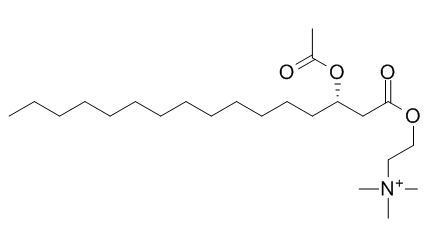Pahutoxin
Pahutoxin is a natural fish-killing (ichthyotoxic) agent derived from the defensive secretions of trunkfish. It is also a haemolytic agent.
Inquire / Order:
manager@chemfaces.com
Technical Inquiries:
service@chemfaces.com
Tel:
+86-27-84237783
Fax:
+86-27-84254680
Address:
1 Building, No. 83, CheCheng Rd., Wuhan Economic and Technological Development Zone, Wuhan, Hubei 430056, PRC
Providing storage is as stated on the product vial and the vial is kept tightly sealed, the product can be stored for up to
24 months(2-8C).
Wherever possible, you should prepare and use solutions on the same day. However, if you need to make up stock solutions in advance, we recommend that you store the solution as aliquots in tightly sealed vials at -20C. Generally, these will be useable for up to two weeks. Before use, and prior to opening the vial we recommend that you allow your product to equilibrate to room temperature for at least 1 hour.
Need more advice on solubility, usage and handling? Please email to: service@chemfaces.com
The packaging of the product may have turned upside down during transportation, resulting in the natural compounds adhering to the neck or cap of the vial. take the vial out of its packaging and gently shake to let the compounds fall to the bottom of the vial. for liquid products, centrifuge at 200-500 RPM to gather the liquid at the bottom of the vial. try to avoid loss or contamination during handling.
Journal of Food Quality2022, P:13, 6256310.
J Biosci.2020, 45:46.
Front Pharmacol.2025, 16:1611342.
Environ Toxicol.2021, doi: 10.1002
Legume Science2021, 3(4): e101.
Evid Based Complement Alternat Med.2018, 2018:8565132
Korean Herb. Med. Inf.2020, 8(2):233-242.
Fermentation2023, 9(10), 889
Food Addit Contam Part A Chem Anal Control Expo Risk Assess.2020, 37(9):1437-1448.
Toxins (Basel).2020, 12(4):210.
Related and Featured Products
Toxicon. 2003 Jul;42(1):63-71.
Receptor-mediated toxicity of pahutoxin, a marine trunkfish surfactant.[Pubmed:
12893062 ]
Pahutoxin (PHN, choline chloride ester of 3-acetoxypalmitic acid) is a natural fish-killing (ichthyotoxic) agent derived from the defensive secretions of trunkfish. In spite of its obvious structural resemblance to synthetic cationic long-chain quaternary ammonium detergents, we show that PHN's action does not rely on its surfactant properties and is in fact, receptor-mediated.
METHODS AND RESULTS:
The above conclusion is supported by the following data: 1. Ichthyotoxicity is not related to its detergency or surfactivity, as indicated by the fact that the lethal concentration is about 1.5 orders of magnitude below its critical micelle concentration value (69 microM) and its liposomal/seawater partition coefficient is low (62-85); 2. The trunkfish is tolerant to its own Pahutoxin; 3. Ichthyotoxicity occurs only upon application to the surrounding water, suggesting the existence of externally located receptors; 4. The receptor hypothesis was supported by the aid of equilibrium saturation binding assays revealing the presence of specific binding sites to PHN on the fish gill membranes; 5. The PHN tolerant trunkfish was shown to be devoid of PHN-binding sites. Some chemo-ecological, and environmental implications are discussed.
Toxicon. 2004 Dec 15;44(8):939-42.
Endogenous regulation of the functional duality of pahutoxin, a marine trunkfish surfactant.[Pubmed:
15530977]
Pahutoxin (PHN) is a long chain detergent-like quaternary ammonium cationic substance derived from defensive skin secretions of trunkfish. A recent study has revealed that PHN's ichthyotoxicity and its phospholipid membrane disruption effect are produced by two separate mechanisms, which presumably represent two separate physicochemical domains in the PHN molecule [Kalmanzon, E., Rahamim, Y., Barenholz, Y., Carmeli, S., Zlotkin, E., 2003. Receptor-mediated toxicity of Pahutoxin, a marine trunkfish surfactant. Toxicon 42, 63-71].
METHODS AND RESULTS:
Here we report on the occurrence of a natural endogenous mechanism, which regulates the above PHN's functional duality. The regulation is performed by the aid of two separates constituents of the trunkfish secretion, which either selectively amplify PHN's ichthyotoxicity (factor I) or suppress its phospholipids permeabilization effect (factor II). The ecological significance of such endogenous regulation is discussed.
Toxicon. 1987;25(4):459-61.
Occurrence of pahutoxin and homopahutoxin in the mucus secretion of the Japanese boxfish.[Pubmed:
3617085]
METHODS AND RESULTS:
The mucus secreted by the Japanese boxfish O. immaculatus was extracted with n-butanol. The extract was fractionated by silica gel open column chromatography and reversed phase high performance liquid chromatography to give two hemolytic components.
CONCLUSIONS:
The major hemolysin was identical with Pahutoxin which was previously isolated from the Hawaiian boxfish O. lentiginosus, while the other hemolysin was a new choline chloride ester, named homoPahutoxin.



